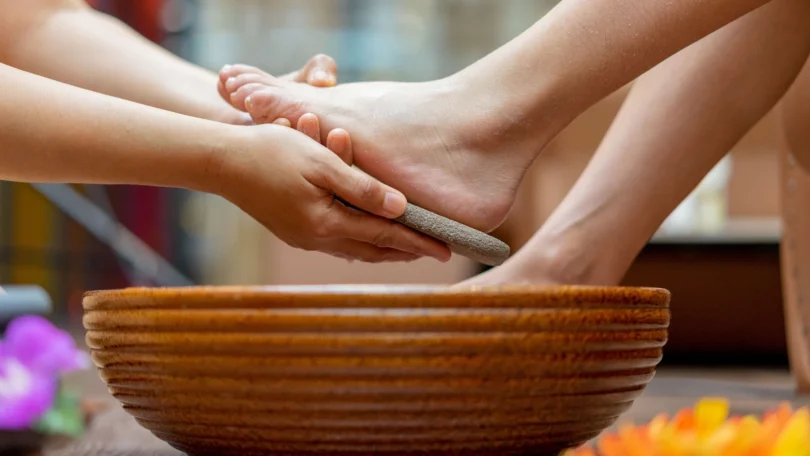Trekking to Everest Base Camp, the most popular base camp on earth – Hike to EBC is a lifetime experience for many people all over the world visiting the foundation of the world’s highest mountains with the vision of standing at its peak. When you are planning the Best Mount Everest Base Camp Trek, it’s easy to get bogged down in the logistics of things like the Mount Everest Base Camp Trek Itinerary and what comes with the Cost of an Everest Base Camp Trek but, when it all comes down to it – humble bastards that they are – it will be your feet that make or break your trip.
A shocking number of trekkers, during a hike to Everest Base Camp, suffer from crippling problems because of Bad Foot treatment, which turns your dream EBC Trekking adventure into a painful crawl. This ultimate guide has it all – from how to find the Ultimate Guide to Planning Your Best Everest Base Camp Trek to what you absolutely need to know in How To Keep Your Feet Happy and Healthy for 12 Days.
Find your way to the (ect) Everest Base Camp Trek – How long is it?
In terms of tackling the EBC trek, it is a large mission, not best of coins, however, also an investment of 1’s frame and capacity to deliver, each day, in pretty tough surroundings. And it is this constant, repetitive rolling over varying terrain, including all the jagged rocks, and the frigid cold wetness that your feet are subjected to, that makes foot health so crucial. This isn’t just a day hike—it’s an expedition, and even the smallest blister or fungal infection can threaten to derail your Mount Everest Base Camp Trek. This trek to Everest Base Camp and there is the same attention to look after your feet as an awareness of altitude.
The Foundation: Choose Your Shoes and Preppin’ Them for the Streets
Your footwear is the most critical piece of gear that belongs in their individual space on my Everest Base Camp Packing List since you want your feet to be happy as you embark on your Everest Base Camp Tour! 1.) Waterproof and with good ankle support are three key attributes to look for when purchasing a hiking boot; but most importantly, you’ll want your hiking boots to be ½ size- full-sized *larger than your normal “street” shoe. And the single most important thing to prepare: Wear your boots for 6 months (on long, weighted hikes) PRIOR to you heading off on the Hike To Everest Base Camp so that they have plenty of time to mold themselves exactly to the shape of YOUR feet and remove any chance of pressure points. Cut this step out, and the best way is to tear your feet with blisters or pain on the track.
The Next-to-Skin: The Physics of Hiking Socks
Selecting the right style of socks can be as important as choosing your boots when it comes to preventing issues while on trek, like the EBC trekking trail. Socks made of cotton are bad: “Cotton absorbs moisture, so then it’s stuck against your skin,” and gives you the perfect recipe for blisters or trench foot; she recommends going synthetic. Instead, you’ve got to get a two-layer solution about it: Start with a cheap manmade or merino wool liner sock that is designed to wet itself while wicking moisture away from your skin. The liner sock, which you actually touch your skin to, is there to handle the friction and move around on the outer sock rather than bind up against you. You’ll need to pack six pairs of the liner socks and three pairs of the outer ones, so that you always have a dry, clean pair for your two weeks.
The Daily Ritual: Here’s How You Can Keep Your Feet Happy and Healthy for 12 Days Straight
Don’t take the chance of worthless the hard work you have done till now by ignoring your foot health when you are on a trek to Everest Base Camp. At lunch, you should remove your boots and socks, giving your feet a chance to breathe every day for at least thirty minutes. This is also when you should inspect your feet for any “hot spots” — small, red or tender spots that suggest a blister is imminent. You see a hot spot, you stop it in its tracks by applying a piece of medical tape or hydrocolloid patch onto the scene of the crime so it doesn’t become a situation gone wild.
Climate challenge: Moisture and temperature control
Foot care management becomes a particular issue in the cold, wet environment of highland Khumbu. If you have night shakes in cold feet, like the heat at night & sweat plenty days hard walks. To negate this, bring along 100% dry, thick thermal sleeping socks and only use them for sleep (never walking). If you do, remove those wet socks with the quickness, no matter if it’s beneath a ledge and in the chill: Walking with wet socks causes your skin barrier on your feet to go down the tu, be, and uncomfortable sores may be beckoned. Keep Your Feet Dry. After walking in wet conditions for hours during ourEverestt base camp trek, we always changed into 100% dry socks when sleeping.
Pre-Tape and First Aid – There are Preventive Alternatives
Absolutely, prevention is better than a remedy for the Mount Everest Base Camp tour. When you have a record of blisters on some specific places (say, the heels or balls of your feet, each morning, earlier than taking walks, apply athletic tape to them to prevent blisters from happening, or use committed blister tape (like Leukotape). This layer of tape is like your artificial skin, and the friction goes through instead of your skin. Some things I always carry in my personal first aid kit are a clean needle, antiseptic wipes, antibiotic ointment, and moleskin AND hydrocolloid pads of various sizes (like Compeed) for throbbing blister-killing treatment if one makes it past my preventions.
The Pain Barrier: Treating and Pushing on the Trail
Painful or tense blister: If you have a painful, tense blister on your Everest base camp trek, then address it now before it stops you. Other than that, you don’t need to do anything unless the blister is small and unbroken, in which case you should leave it alone (meaning in place with your skin covering) and cover it with a hydrocolloid patch, along with a moleskin ring to protect from pressure. If it is a large, painful blister, you should try to drain it before proceeding. Puncture the blister (at the edge) with a clean needle and let out the fluid, then apply an antiseptic before covering it with plaster — but keep the skin of the blister so it can protect the tissue underneath. You can probably tape and sponge up your feet mightily enough to limp along without it ultimately threatening your chances of making it to Everest Base Camp, but toughing through does almost no one any good.
Conclusion
Everest Base Camp trek is, of course, a life-changing and heart-pounding challenge that demands total dedication to achieve, but how to ensure you cover all the Everest Base Camp Trek Distance is actually quite literally right under your nose. And with the right boots, a rock-solid sock strategy, and a daily foot-care ritual, you’ll be able to avoid most of the troubles that struck other hikers. A foot problem can crash your chances of reaching EBC. Look after your tootsies – and should you do, following the advice in this guide, you’ll be more than prepared to enjoy each step of thEverestst base camp hike in comfort, confidence, and good health.






